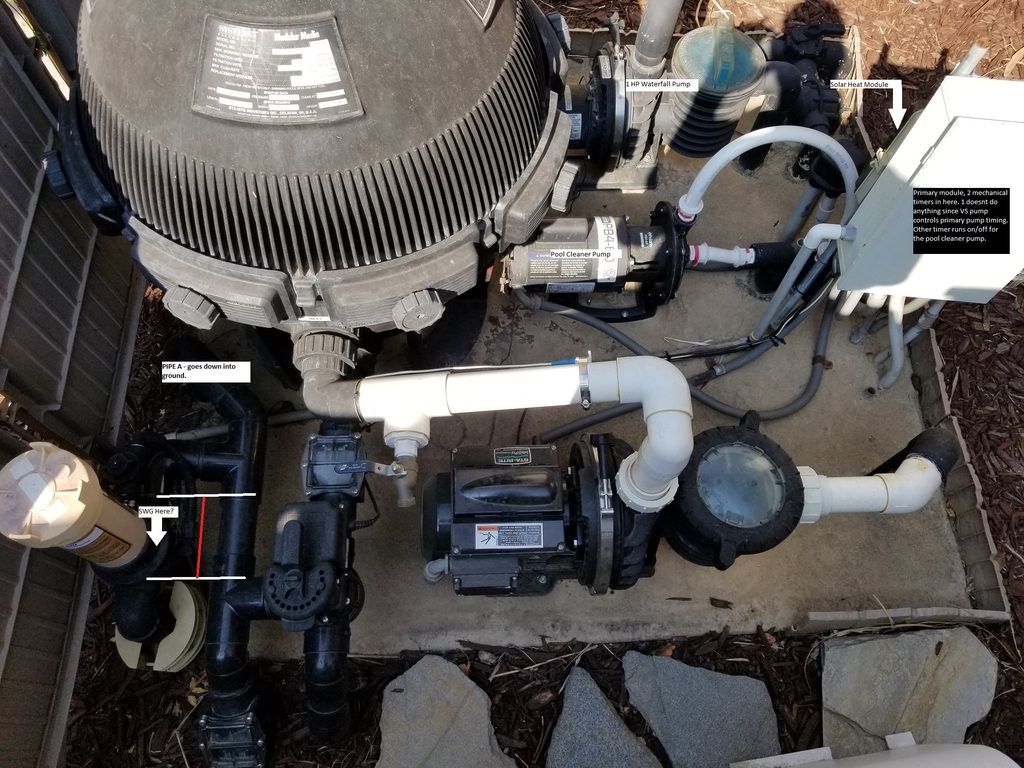Hi all, I'm just starting down the road of evaluating the purchase of a SWG. Before I do that I wanted to ask a few questions. I am currently eyeing a CircuPool RJ20 (rated for 20k gallons). Most of my questions are pumping and equipment related, but I can shift over a few of the SWG specific questions to the SWG section of the forum if appropriate.
1 - My pool is kidney shaped with sloping depth so getting a gallons estimate is tricky. I think it is around 14k gallons (+/- 5k gallons). Would the RJ20 rated for 20k gallons be sufficient, or safer to jump to the RJ30 rated at 30k gallons? Price difference is about 10% increase.
2 - I downloaded the install manual to see how it goes in. See my below picture of my equipment pad. Easy as removing my inline chlorine tab holder? Note that the inline tab holder isn't in use and hasn't been for years. I manually add chlorine using the HASA jugs from the pool store. It looks like there isn't enough space with existing plumbing to just swap out the inline chlorine tab hopper for the SWG unit. Anyone has pictures of creative plumbing to solve for this? My brother and I installed the current VS pump and all of the white plumbing is what we did, i.e., we're not novices, but seems tricky to create a new section to house the SWG in what is currently a very tight area (the distance of the red line is 6 inches).
3 - The VS pump is a Pentair, which has a cord running out of it to the solar heating module. It looks like in the install instructions, the SWG module needs to plug into the pump as well? Not sure how this would work.
4 - Where does the pipe in my picture labeled PIPE A go?
Thanks! I'm located in Sacramento if there are any retirees that would want to come over and offer up opinions and advice!

1 - My pool is kidney shaped with sloping depth so getting a gallons estimate is tricky. I think it is around 14k gallons (+/- 5k gallons). Would the RJ20 rated for 20k gallons be sufficient, or safer to jump to the RJ30 rated at 30k gallons? Price difference is about 10% increase.
2 - I downloaded the install manual to see how it goes in. See my below picture of my equipment pad. Easy as removing my inline chlorine tab holder? Note that the inline tab holder isn't in use and hasn't been for years. I manually add chlorine using the HASA jugs from the pool store. It looks like there isn't enough space with existing plumbing to just swap out the inline chlorine tab hopper for the SWG unit. Anyone has pictures of creative plumbing to solve for this? My brother and I installed the current VS pump and all of the white plumbing is what we did, i.e., we're not novices, but seems tricky to create a new section to house the SWG in what is currently a very tight area (the distance of the red line is 6 inches).
3 - The VS pump is a Pentair, which has a cord running out of it to the solar heating module. It looks like in the install instructions, the SWG module needs to plug into the pump as well? Not sure how this would work.
4 - Where does the pipe in my picture labeled PIPE A go?
Thanks! I'm located in Sacramento if there are any retirees that would want to come over and offer up opinions and advice!



